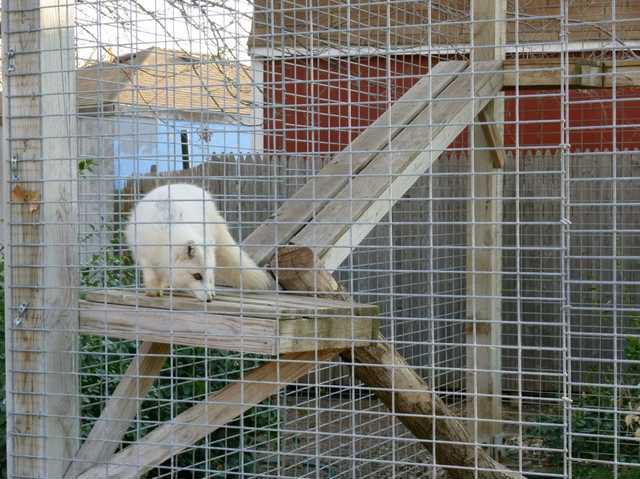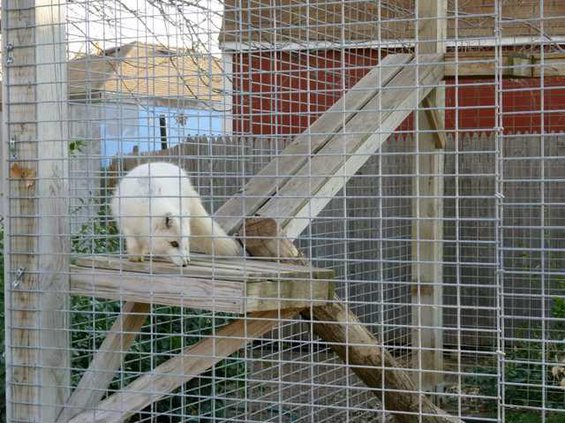Members of the Great Bend Zoological Society got an early look Friday at Vixey, the new arctic fox at the Brit Spaugh Zoo. As the 11-month-old fox was released into her spacious new enclosure, she capered through the grass, inspecting every corner, and climbed every perch.
The fox arrived here last December and has been in quarantine until now. She is housed in the enclosure where the bobcats used to be and can be seen during regular zoo hours, which are 9 a.m. to 4:30 p.m. daily.
Zoo Director Scott Gregory said it is standard policy to keep new animals like Vixey sequestered for a few weeks. In this case it proved to be beneficial, because the fox had hookworms. The parasites could have spread to other animals in the zoo if not treated first.
“We are getting a male fox from the Como Zoo in St. Paul, Minn.,” Gregory said. “It hasn’t been born yet.” But once a male arctic fox is added at the zoo, the plan is to breed the animals. Although arctic foxes are not an endangered species, there is a conservation concern because their numbers have declined in some of their native areas.
The fox is still showing her bright white winter coat, but once the weather warms up she will shed much of that, revealing a gray coat, Gregory said. And even though these animals can live in arctic conditions with temperatures of 50 degrees below zero, they reportedly do fine in warmer climate zoos. Gregory said he worked at a Florida zoo that had a pair of them.
Three more animals
One benefit of being a Zoo Society member is getting to see new animals ahead of the general public, said Joe Cannon, president of the zoo’s support organization. On Friday, members got to see three other new animals that will be used for education purposes: a chinchilla, a short-tailed opossum and a white rabbit. These animals, all suitable for petting, can be taken to schools or shown to children who attend educational programs at the zoo.
The rabbit is an ordinary white bunny that has had an incredible string of good luck at the zoo, Gregory said. “The rabbit was purchased for eagle food,” he said. Great Bend’s zoo also houses a raptor rehabilitation project, and the rabbit was purchased to feed to an injured eagle that wasn’t responding to the usual diet of mice. The eagle also chose not to each the rabbit, so the staff tried to feed it to another eagle, which also decided it wasn’t hungry. After that it might have been fed to a boa constrictor, but at some point the staff felt it had earned a pardon.
“This is an extremely luck rabbit. We love him and we use him for education now,” Gregory said.
The chinchilla and short-tailed opossum are both native animals of South America. The opossum isn’t like the North American opossums that are common in this area, Gregory said. Opening a pet taxi, he pulled out a kitchen match box and opened it to reveal the full-grown opossum. Its body is no more than 4 inches long, with a tail nearly as long as the animal.
Geriatric animals
Gregory gave an update on other things going on at the zoo, including the lab results done after Spirit, a white Bengal tiger, died earlier this month. It was about 15 years old.
“We still don’t have results of why he died,” Gregory said. “We know he had some form of cancer.” Sunny, the yellow Bengal at the zoo, was Spirit’s litter mate and he is healthy. Spirit had suffered from health problems for some time.
Brit Spaugh Zoo has an aging animal population with “many geriatric animals,” Gregory said. Spidey, the 43-year-old Spider monkey, is believed to be the oldest of his breed in a U.S. zoo, and the second-oldest in the world.
“We’re trying to bring in younger animals, and we’re trying to bring in animals for breeding projects,” Gregory said. “We have just secured a female sloth (that) we’ll breed with the male.”
As for what animal may replace Spirit, Gregory said he wants the next tiger the zoo acquires to be more exotic than the Bengals. “We have feelers out for a Siberian tiger cub and lion cubs,” he said. While the Siberian cats look about the same to the lay person, Gregory said the zoo considers conservation and education opportunities as well as their appeal to the public when considering new animals.
New at Brit Spaugh Zoo: Four new animals revealed





